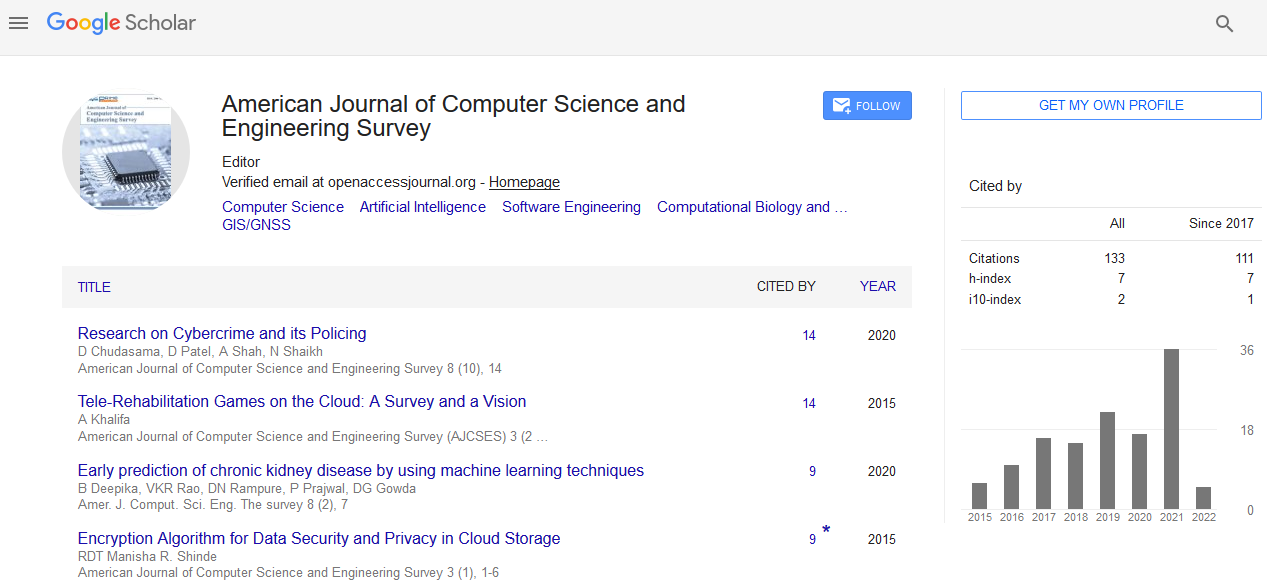Commentary - (2024) Volume 12, Issue 1
Understanding Hardware Functioning in Computer Systems
Sutton Dean*
Department of Electronics and Communication, University of Bolton, United Kingdom
*Correspondence:
Sutton Dean,
Department of Electronics and Communication, University of Bolton,
United Kingdom,
Email:
Received: 28-Feb-2024, Manuscript No. IPACSES-24-19982;
Editor assigned: 01-Mar-2024, Pre QC No. IPACSES-24-19982 (PQ);
Reviewed: 15-Mar-2024, QC No. IPACSES-24-19982;
Revised: 20-Mar-2024, Manuscript No. IPACSES-24-19982 (R);
Published:
27-Mar-2024, DOI: 10.36846/2349-7238.24.12.05
Description
The functioning of hardware components in computer systems
is fundamental to their operation. This paper provides an
overview of hardware components, their roles, interactions, and
the principles underlying their functioning. It covers The Central
Processing Unit (CPU), memory, storage devices, input/output
(I/O) devices, and the role of the motherboard in coordinating
their activities. Additionally, it discusses key concepts such as the
fetch-decode-execute cycle, bus architecture, and interrupts.
Understanding hardware functioning is crucial for computer
scientists, engineers, and enthusiasts alike, as it forms the
basis for designing, troubleshooting, and optimizing computer
systems. Computer hardware encompasses the physical
components of a computer system, including the Central
Processing Unit (CPU), memory, storage devices, input/output
(I/O) devices, and the motherboard. The collective functioning
of these components enables a computer to perform various
tasks, from simple calculations to complex computations.
This paper aims to elucidate the functioning of hardware
components and their interactions within a computer system.
The CPU serves as the brain of the computer, responsible for
executing instructions and performing calculations. It consists
of several key components, including the Arithmetic Logic Unit
(ALU), control unit, and registers. The CPU fetches instructions
from memory, decodes them, and executes them sequentially,
following the fetch-decode-execute cycle. Clock speed, cache
size, and the number of cores are important factors influencing
CPU performance. Memory in a computer system refers to
the temporary storage used to hold data and instructions that
the CPU needs to access quickly. There are different types
of memory, including Random Access Memory (RAM) and
Read-Only Memory (ROM). RAM is volatile memory used for
storing data and program instructions temporarily, while ROM
contains essential system instructions and is non-volatile.
Memory hierarchy, including cache memory, plays a crucial role
in optimizing CPU performance. Storage devices, such as Hard
Disk Drives (HDDs), Solid-State Drives (SSDs), and optical drives,
provide non-volatile storage for data and programs. HDDs use
rotating magnetic disks to store data, while SSDs utilize flash
memory for faster access times. Storage capacity, access speed,
and reliability are important considerations when choosing
storage devices for a computer system. I/O devices enable users
to interact with the computer system and exchange data with
the outside world. Examples include keyboards, mice, monitors,
printers, and network adapters. Input devices allow users to
input data into the computer, while output devices display
or transmit processed information. Peripheral Component
Interconnect (PCI) and Universal Serial Bus (USB) are common
interfaces for connecting I/O devices to the motherboard. The
motherboard serves as the main circuit board in a computer
system, providing connectivity and communication between
hardware components. It houses the CPU, memory modules,
expansion slots, and connectors for various I/O devices.
The chipset on the motherboard facilitates communication
between the CPU, memory, and peripheral devices through
buses and controllers. Several fundamental principles govern
the functioning of hardware components in a computer system:
Fetch-Decode-Execute Cycle: The CPU fetches instructions
from memory, decodes them into executable commands, and
executes them sequentially. Bus Architecture: Buses facilitate
communication between hardware components by carrying
data, addresses, and control signals. Interrupts: Interrupts
are signals generated by hardware devices to request
attention from the CPU, allowing for asynchronous handling
of events and multitasking. Understanding the functioning of
hardware components is essential for designing, building, and
troubleshooting computer systems.
Acknowledgement
None.
Conflict Of Interest
None.
Citation: Dean S (2024) Understanding Hardware Functioning in Computer Systems. Am J Comp Science. 12:05.
Copyright: © 2024 Dean S. This is an open-access article distributed under the terms of the Creative Commons Attribution License, which permits unrestricted use, distribution and reproduction in any medium, provided the original author and source are credited.

